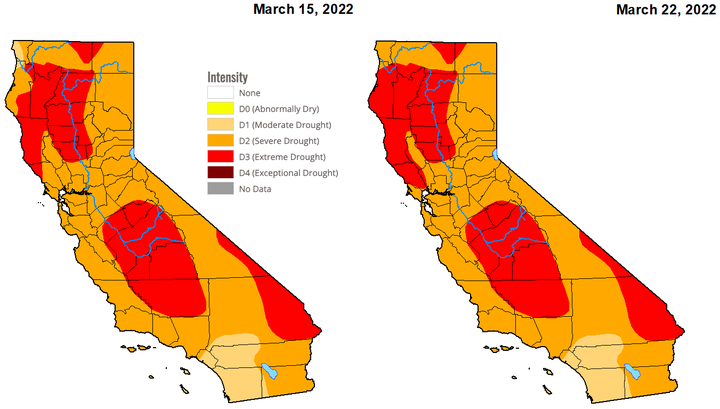Local precipitation totals for the month of March are shaping up to be the lowest ever recorded. While late December and early January storms started the season with great promise, historic drought conditions have gripped Humboldt County.
“Our total precipitation in Eureka for the year so far is a whole 3.83 inches,” James White, a meteorologist with the National Weather Service office in Eureka, told the Outpost. “That is the lowest precipitation level recorded since record-keeping began over 100 years ago. We had the driest January and February on record and that trend will probably continue for the month of March.”
Eureka has received 1.4 inches of precipitation this month, about three inches below normal, he said. On average, the Humboldt Bay region receives just under 17 inches of precipitation by mid-March.
Much of the state has reported severe to extreme drought conditions, aside from a swath of moderate drought conditions along the Southern California coast, according to data from the U.S. Drought Monitor. Just this week, local drought conditions shifted from overwhelmingly severe to extreme.
Drought conditions have worsened across Humboldt County in the last week | U.S. Drought Monitor
“That’s one category below the highest which is exceptional drought,” White explained. “If the lack of precipitation continues, we’ll probably fall into that category before too long. …We could always get some more rain in April, but long-range forecasts don’t look too great at the moment.”
This means yet another year of strained water resources, lower than average river levels and increased fire potential throughout the North Coast.
“In short, it’s very dry throughout the county, setting the stage for what could be a devastating fire season,” Ryan Derby, Humboldt County Office of Emergency Services (OES) Manager, told the Outpost in an email. “…At this point in the season, any rainfall we receive is beneficial but likely won’t have a significant impact on the drought overall. What we really need in order to see improvement in drought conditions is light-to-moderate rain over a prolonged period of time, as opposed to a lot of rain at once. It has been fairly dry since October, with a few significant rain events in more recent months, but nothing that will turn the drought around.”
Speaking from an emergency preparedness perspective, Derby said he is focused on wildfire preparedness and conducting community outreach.
“Internally, OES is working on building depth in our Emergency Operations Center (EOC) staff by providing training and testing our systems to ensure functionality prior to peak fire season,” he said. “OES is also engaging in preparedness talks with high fire-prone areas of the county to discuss evacuation zones, emergency alerts and personal preparedness planning.”
Derby encouraged residents to find their evacuation zone through the Zonehaven Evacuation Management platform and prepare an evacuation checklist. Local residents should also sign up for emergency notifications from the county here.
The Humboldt County Board of Supervisors voted to approve the ongoing local drought emergency last month and again on Tuesday on the advice of the county’s Drought Task Force, which has shifted its focus to policy recommendations and compliance with Senate Bill 552. That bill concerns drought planning for small water suppliers and rural communities at risk of water shortage and drought vulnerability.
Assembly Bill 2451, a new bill introduced by Assemblymember Jim Wood (D-Santa Rosa), would require the State Water Resources Control Board “to establish a Drought Section within the Division of Water Rights” and adopt new “principles and guidelines for diversion and use of water in coastal watersheds during times of water shortage.”
“Drought is a statewide catastrophe,” Wood wrote in an email to the Outpost. “In my district, I am especially worried about the coastal watersheds, especially as demand continues to exceed annual rainfall in most cases. This year I have a bill, AB 2451, which would establish a new unit at the water board focused specifically on drought preparedness. It would develop a pilot project for watersheds in Northern California. We need to have long-term plans in place not after the fact or a few months before disaster strikes.”
State Sen. Mike McGuire’s climate emergency declaration, Senate Concurrent Resolution (SCR) No. 53, passed the state Senate with bipartisan support, 30-4, last month and moved forward to the state Assembly. However, the bill has been “held at desk,” in part because of the use of the phrase “climate emergency.”
“SCR 53 declares that, ‘the climate emergency threatens the state, the nation, the planet, the natural world, and all of humanity.’ Given the concordance of such a wide body of scientific evidence supporting this fact, there is little doubt this is true,” according to the legislative analysis of the bill. “However, the term ‘climate emergency’ does not appear in California statute and merits further consideration.”
Reached by phone this afternoon, McGuire acknowledged the “dire situation” facing Californians.
“We know that the planet has hit a tipping point and the effects of climate change are accelerating,” he said. “Here in California and throughout the American West, we’re seeing extreme wildfires and record-breaking temperatures. …We have to change our thinking. The state of California is investing literally billions of dollars this year and next to help our communities prepare for what will be a drier climate in the decades to come.”
Gov. Gavin Newsom advanced $15 billion in funding last fall through the California Comeback Plan to build wildfire and forest resilience, support immediate drought response and long-term water resilience, and directly protect communities across the state from multi-faceted climate risks, including extreme heat and sea-level rise.
“California needs to move forward with even more aggressive policies,” McGuire said. “We can no longer be in a reactive mode. We have to become much more proactive which means we have to advance aggressive policy along with associated financial investments to help prepare our communities. It is going to be incredibly challenging, but California can lead the way.”

CLICK TO MANAGE